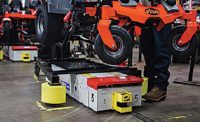Automotive manufacturers face several ongoing challenges, such as being able to introduce new products onto an assembly line without long retooling times. One American Tier 1 supplier that manufactures suspension modules recently met this specific challenge by using a rail-guided carts (RGCs) assembly line.
The company was looking for a more flexible and cost-efficient assembly line than the conventional conveyor-belt-based one they had frequently used before. Eventually, its representatives discussed the project at length with Fori Automation Inc., which designs and builds material handling, assembly, testing and welding systems.
Fori recommended a scalable and versatile assembly line based on its RGCs, which can move in multiple directions. Each cart features a poka-yoke mechanism, a PLC for processing data, a safety bumper, an emergency stop switch and optional safety scanners.
Equally important, the line includes a flexible communications platform for all cart control, diagnostic and safety functions, says Dean Colwell, controls engineering manager for assembly and welding systems at Fori.
Three technologies from Siemens are used in the platform. The TIA Portal engineering framework permits commissioning and configuration of all system components from one central location. Simatic S7-1200 controllers offer cost-efficient connections within the system architecture and to the higher-level host system.
Scalance W products enable wireless communication and include access points, client modules, RCoax cable, antennas and accessories. Having wireless capability is essential for the automaker, because the RGCs are autonomous and cannot be connected to a fieldbus system for the transfer of control signals or warnings.
Scalance products have data rates up to 1,733 megabits per second, and they can connect with industrial networks, such as Profinet with PROFIsafe. The products provide real-time communication and fast roaming, and can be used in the control cabinet.
Diagnostic data is continuously available to the automaker via an HMI and on the Portal, and all error messages are displayed in plain text. The assembly line is comprehensively protected against unauthorized modifications to code or process values, both in the PLC and the Portal.
Because the PLCs communicate with each other, operators can easily create lists and monitor production. Colwell points out that although each RGC safety-switching device has to have a specific function, the parameters might change frequently depending on the cart’s working range. This capability is not possible with conventional hard-wired safety systems.
“The flexible cart system costs the same as a conventional conveyor system,” claims Dan Connelly, head of the Fori Assembly Lines division. “Yet it combines all the benefits of [the latter by] incorporating pallets with the advantages of 360-degree operator access. We can configure the line with stops or [to be] continuous to make the process much more flexible, productive and cost-efficient.”
Connelly says the RGC line requires about 25 percent less time and labor to install, and it can be quickly configured to match the assembly process at hand or the available space. Equally important, material racks can be located both outside and inside the assembly line.
For more information on communications platform technologies, call 800-241-4453 or visit www.siemens.com. For more information on systems integration, call 586-247-2336 or visit www.foriauto.com.







